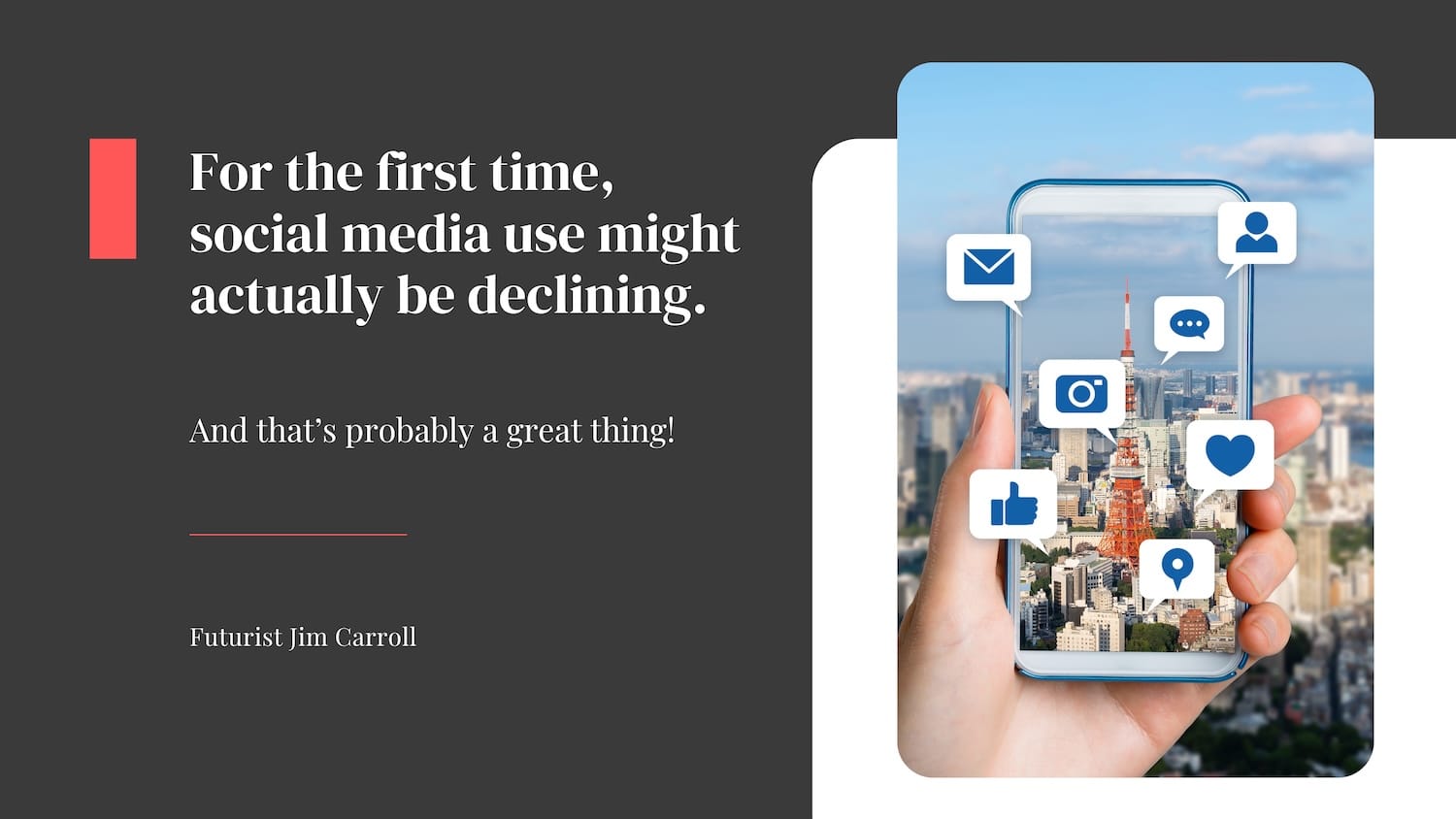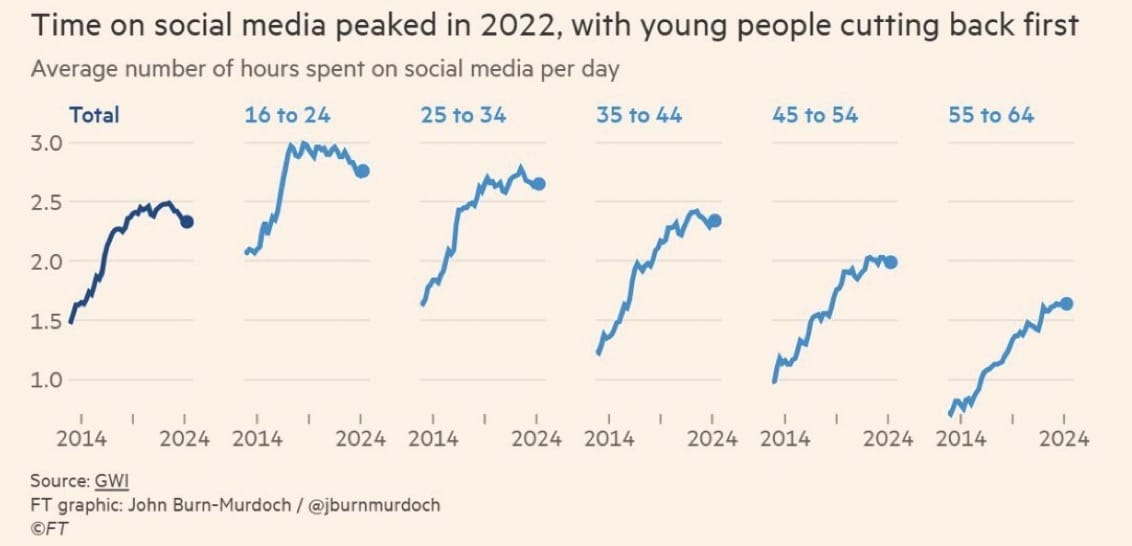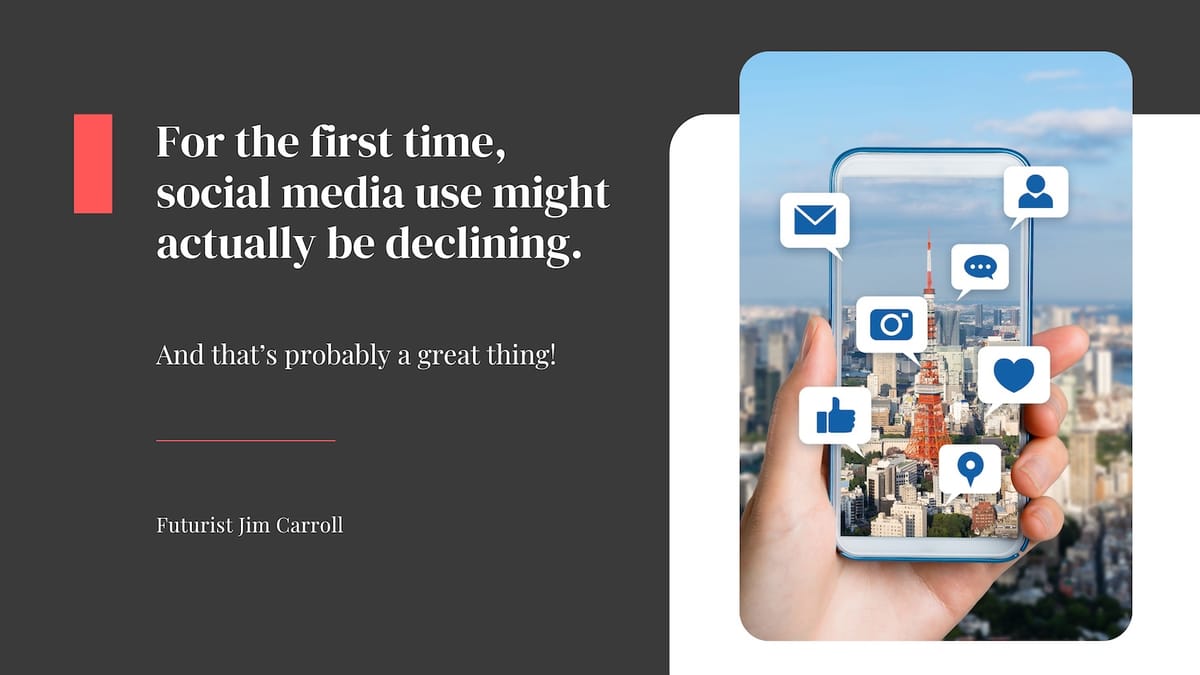"For the first time, social media use might actually be declining. And that's probably a great thing!" - Futurist Jim Carroll

Some months ago, I became a first-time grandfather, and I must say, these are some of the most magical moments of my life!
But you wouldn't know it by my social media posts, because I haven't been posting any pictures.
And in fact, you probably won't see many photos of my grandchild online, all at the same time that my engagement with the online world continues to decrease. So I'll share, for a moment, this moment of joy that is my life at this moment!

My lack of posting comes at the request of the parents of the child, my son and his wife. Through a few conversations, they politely but firmly made it known that they were not supportive of sharing the child on social media.
I'm respecting that.
I'm also learning a lot.
It's become fascinating to me to realize that while they grew up with social media - MSN, MySpace, Facebook, Twitter, Tumblr - they've also come to almost entirely reject it going forward. In fact, other than their momentary scrolling of news feeds, they rarely post anything online, let alone engage. There was one single birth announcement that went out that made it "Instagram-official."
Think about that - the first social media generation seems to be rejecting social media going forward. And that's not just my own observation - it was recently covered in a comprehensive but barely noticed report in the Financial Times earlier this month. Time on social media actually began to peak in 2022!

With this, I've come to challenge my own involvement with social media and have dramatically scaled back as a result.
Facebook? It's become a swamp of advertisements, the occasional update by a friend buried among the rubble. Twitter? A toxic hate swap - I'll only venture in there for weather reports or news updates, but abandoned my posting many years ago when Elon Musk jumped the sanity shark and subsumed his mind into madness. Instagram remains a curiosity but exists quite simply for some mindless swiping. I do admit to venturing into TikTok for some minutes each day, because it has, for me, so far, just been a wonderful humor escape. And then there is LinkedIn. I'm not really sure it's useful for 'professional networking' anymore, since it seems to have just become a forum for professional boasting.
All of this has been made even worse by the arrival of AI slop. I'll admit it - I've been guilty of it too. But suffice it to say, social media now seems to have become an endless supply of AI-generated content, much of it meaningless drivel.
At the same time, we are seeing the reality of the mindless pursuit of profit and power that are the CEOs of modern-day social media and technology behemoths. It seems that at every other moment, we are seeing the CEOs of these very companies choosing to prostrate themselves on their knees, ready to do whatever is necessary to debase their moral beliefs in the pursuit of their goals. Gavin Newsom just joked that he will buy them knee-pads to help them out, and maybe he is on to something!
I've long had a tenous and marginal relationship with social media. From 2006 to 2012, I spent a lot of time on stages for organizations ranging from Burger King to Taco Bell to the PGA of America, explaining the profound impact that the technology would have on their customer relationships and their brands. Most of what I predicted came true at an astonishing speed, and I've watched carefully as all of them have both failed and succeeded with new and altered dynamics.
And for a time, I worked to be a social media dynamo, working to build my follower count, engage continuously, and interact relentlessly. But I never managed to do that - perhaps because my content never rose to the level of the hateful bile that the algorithm seems to prefer today.
I've also watched, as many have, the emergence of social media as a profoundly destructive force -
one that encourages fraud, manipulation of opinion, relentless attacks, hate, and anger. I wrote about this years ago in my post on 'Bad Things' - one of the most negative pieces I have written. Sadly, all this seems to be coming true - check point #2. This is what social media has done.
Acceleration of mental illness: We are seeing a new form of collaborative mental illness driven by the connectivity of the Internet, and years from now, it will be diagnosed as such. This is not any type of routine mental illness – this is full-on whack-a-doodle loopy-doo full-on-gone type of crazy. Like, beyond batshit. You know them when you see them; you feel for their families. This has obviously become a massive part of the political agenda – people subscribe to the craziest of conspiracy theories. Your crazy uncle is now everywhere all at once – you are surrounded by too many crazy uncles. Crazy feeds on crazy, and so the new iterative insanity loop drives more insanity. It won’t end well.
And so here we are!
I'll continue to post here and there, but by and large, I'll take a deep breath, think through what I might want ot say, and then won't say it! If I concentrate my efforts anywhere, it will be on LinkedIn and Mastodon, but I won't be a boasting machine!
And I'm going to savor every moment with my new grandchild!
Have we passed peak social media?
As platforms degrade into outrage and slop, users are turning away
Financial Times, October 3, 2025
In years to come, we may well look back on September 2025 as the point at which social media jumped the shark and began rapidly accelerating its transition from the place to be seen (through a flattering Instagram filter), to a gaudy backwater of the internet inhabited by those with nothing better to do.
Both Meta and OpenAI have recently announced new social platforms that will be filled with AI-generated short-form videos. This assumes a reservoir of untapped demand for the ability to create and binge-watch yet more content, with a promotional video from OpenAI featuring absurd fantastical animations and deepfakes, hinting at some of what may be to come.
To use a nutritional analogy, this is ultra-processed content. Dopamine-dense, with at best negligible informational value, at worst corrosively negative.
There is sadly considerable appetite for this “slop”. It feeds people’s primal instincts, as evidenced by the multibillion-dollar industry of selling ads against videos of bizarrely soothing sights and sounds, people doing outrageous things, “food porn” and, well, porn.
But the gradual merger of the weird guilty pleasure corner of the internet with the major social media platforms — part of a years-long degradation — appears to be turning people away.
It has gone largely unnoticed that time spent on social media peaked in 2022 and has since gone into steady decline, according to an analysis of the online habits of 250,000 adults in more than 50 countries carried out for the FT by the digital audience insights company GWI. And this is not just the unwinding of a bump in screen time during pandemic lockdowns — usage has traced a smooth curve up and down over the past decade-plus.
Across the developed world, adults aged 16 and older spent an average of two hours and 20 minutes per day on social platforms at the end of 2024, down by almost 10 per cent since 2022. Notably, the decline is most pronounced among the erstwhile heaviest users — teens and 20-somethings.
In many ways, Meta and OpenAI’s new platforms (AI-generated content is already rife on TikTok and YouTube) are a fitting endpoint for social media’s warped evolution from a place where people swapped updates with friends and family, to one with less and less human-to-human interaction. We have now witnessed the transformation of social media into anti-social media with the progressive disappearance of most people from active participation on the platforms and the steady displacement of real-world interactions by scrolling.
Additional data from GWI trace the shift. The shares of people who report using social platforms to stay in touch with their friends, express themselves or meet new people have fallen by more than a quarter since 2014. Meanwhile, reflexively opening the apps to fill up spare time has risen, reflecting a broader pernicious shift from mindful to mindless browsing.
In the parlance of technology writer Cory Doctorow, late-stage social media is a particularly egregious case of the “enshittification” of digital platforms as they resort to ever more desperate methods to capture eyeballs. Many of these apps are no longer really social apps in any meaningful sense of the word; they’re screen time maximising apps, using whatever means necessary to eke out extra seconds and minutes.
It would be a hugely welcome development to discover that we have not merely reached social media saturation point, but that the experience has been degraded to such an extent that it has shocked people out of their stupor and is causing them to pivot to healthier uses of their time.
But that brings me to the catch. There is one notable exception to this promising international trend: North America, where consumption of social media’s diet of extreme rhetoric, engagement bait and slop continues to climb. By 2024 it had reached levels 15 per cent higher than Europe.
The evidence that social media causes harm is highly contested, but these debates often fail to account for how the platforms have fundamentally changed from places of connection to isolation and distraction. One of the strongest cases for harm is that time on these platforms is time away from nourishing interactions with other people. If that trend is reversing, it would surely be no bad thing. If it eventually spreads to America, even better.
Futurist Jim Carroll was an active participant on the earliest forms of 'social media' on services like CompuServe and Usenet, in the 80s and 90s.

